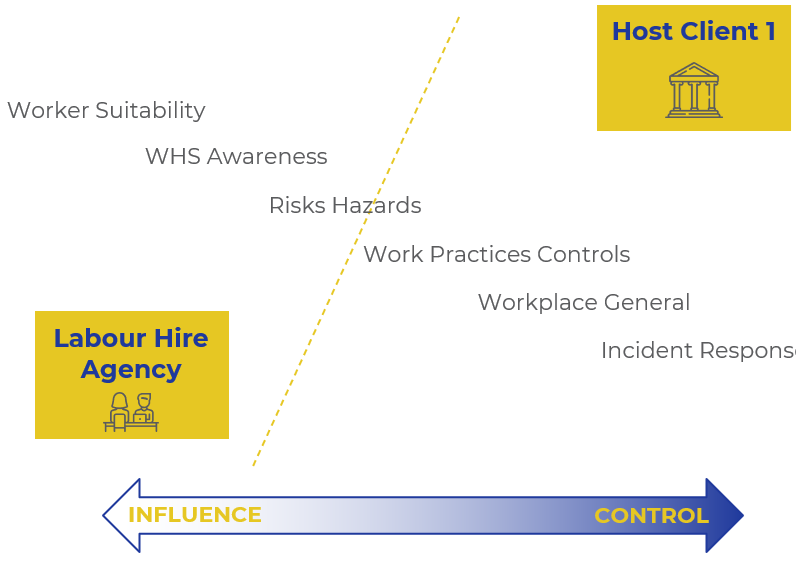Protecting Labour Hire Workers – What about Working from Home?
October is National Safe Work Month.
One key safety issue that is not well understood is the safety responsibility of PCBUs and how to coordinate this responsibility when there are multiple PCBUs.
Even though labour hire agencies have little control over the workplace, they are not completely absolved of responsibility.
“I’m not there, so there’s nothing I can do, right...?”
Actually, there is.
The tricky thing with multiple PCBUs is that they all share a duty of care. Their responsibility is overlapping and non-separable.
This has been shown time and time again in legal cases around the country.
2019 Benalla timber mill fatality
Host Client: D&R Henderson
Labour Hire Agency: Recruitment Select
Mr Kemp was a qualified, competent timber worker. However, the Recruitment Select admitted that they did not realise he had been transferred from the cut-to-size section of the mill to operating the molding machines. Mr Kemp’s clothing became entangled and he was dragged into the machine.
While D&R Henderson was held responsible, Recruitment Select was also fined $50,000 for failing to provide a safe workplace. The judge agreed that the labour hire agency should have known where Mr Kemp was, was he was doing, and whether he had the skills needed to work with the molding machines.
Influence vs control
Consider a standard labour hire situation.
The workplace belongs to the Host Client, and they have control over work practices controls, incident response, and the workplace generally. The agency has control over the worker to be placed at the site – Are they suitable for the role? Do they understand the WHS considerations?
But that’s not it.
Contrary to what many service providers believe, the agency must also be aware of risks and hazards. Only then can they decide whether to place the worker, ensure that the worker has sufficient WHS awareness, and negotiate improvements with the host client if necessary.
Multiple PCBUs can manage safety through third party assessment
Certex’s iSafe Risk Management Program can help manage risks and hazards when multiple PCBUs are involved.
IT worker at a waste site
For example, we work with many agencies placing IT professionals at host client sites.
Recently, an IT worker was placed on a site which turned out to be a waste site. To get to their mobile unit, they had to use the same gateway as waste trucks, and then run across wide roads through internal traffic. There was dust, noise, and many environmental risks.
Guess how much of this the labour hire agency knew?
Nothing. They just had an address.
Fortunately, through an iSafe Risk Assessment, our assessors were able to present our findings to the agency. They could then implement necessary precautionary measures.
Benefits of the iSafe Risk Management Program
Independent
Performed by qualified safety auditors
More economical than second party assessments
Has withstood incident investigations by the workplace and WorkSafe
It is a very thorough assessment looking at both the safety management system AND an inspection of the worksite that could impact the labour hire worker.
The reports are completed by qualified safety auditors, and the host client obtains the report for free – a real bonus for them.
The assessments provide a record that the WHS legal requirements to “consult, cooperate, and coordinate between PCBUs” are being met.
The success of the iSafe Program lies in the fact that it is one visit to the host client, and then that report is shared with all other members of the iSafe Program. This means that the labour hire agency or service provider have lower costs. And for the host client, they undergo the assessment once, not multiple times with different agencies.
In the webinar below, our Managing Director, Dianne Gibert, takes you through the Program in more detail.
Working from home – Potential for worker controls?
At the start of the pandemic, working from home was something we were forced to live with. We endured things like poor lighting, screaming kids, irregular hours, uncomfortable seating, and a workspace that doubled as a kitchen bench, just trying to make it through each day.
Now, it has become more of a personal choice. According to the latest Taking the Pulse of the Nation survey, 70% of Australians who were working from home due to COVID are likely to continue doing so.
However, the uncomfortable bar stool at the kitchen bench is still not good enough for health and safety standards.
But what can employers do? It is pretty hard for them to control workers’ homes.
As the CBD offices empty and more people choose to work from home, employers along may not be able to control workplace health and safety as before.
In fact, it is rather challenging.
Perhaps there is a shift where the worker exhibits greater control over their workplace, as shown below.
What happens when, say, an accident occurs? At home. While you are working from home.
It may be considered a ‘workplace’ accident...
In Germany, a man got out of bed and walked down a spiral staircase to go to his home office. He slipped and broke his back.
The man was compensated by his employer’s insurance company.
The court declared that he was technically ‘commuting’ to work (even if that commute was from the ‘home’ of his bed to his study room).
...or it may not be
An Air Canada call centre employee was working from home. On her scheduled lunch break, she walked down the stairs to go eat. She also slipped and injured herself.
This woman was not compensated.
The judge posited that because she was going out to have lunch, the fall occurred in her ‘personal’ rather than ‘professional’ sphere.
The same staircase fall with two very different outcomes. This begs the question, “Where does one draw the line between these two ‘spheres’?”
Legal nuances aside, it is clear that working from home presents a new set of health and safety challenges for employers and employees.
We are sure to see many more cases that call into question the blurring of the workplace and home.
The future of work
In recent years, working from home has shifted from being a privilege to an expectation – almost a right in some cases.
With working arrangements, businesses must consider the following:
What is the nature of the business? How often do people need to be on-site, if at all? For some, remote work is simply not feasible due to either the nature of their operations (e.g. transport services) or because their success relies heavily on a strong team and culture.
What is the specific role of the worker? Can all or part of their tasks be performed remotely?
Beyond this, business could be open to discussion with employees.
However, we see more and more that pressure to adjust working arrangements is coming from the other side – from individuals telling the business what to do.
This is highly problematic.
Business need to balance the needs of the company with the needs of its workers. Rather than leaving it fully open to negotiation, managers should set clear expectations and protocols upfront.
WFH sustainability in question
If an employee is dissatisfied with work, they can switch jobs. However, it is much more difficult for a business to change its operations or services.
Remote work also paves the way for concerns around work health and safety, including mental health illness due to isolation.
“Businesses are highly competitive, and the greatest asset to any business is its people and its culture. And you’re playing with both of those in a totally unknown space.”
Diane Gibert, Certex Managing Director




